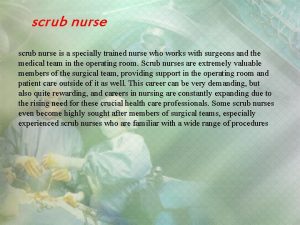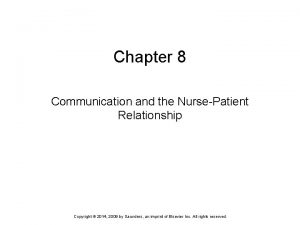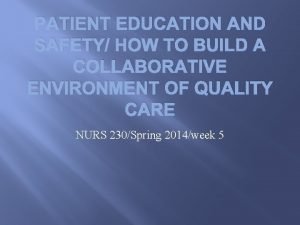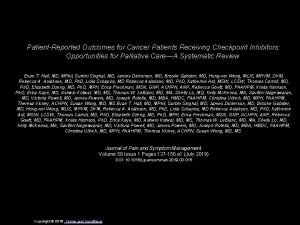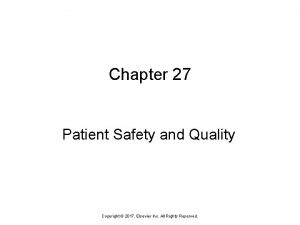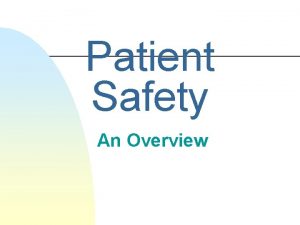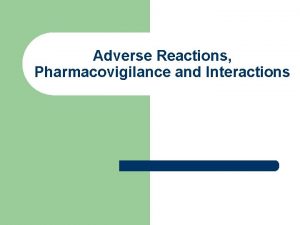Patient Safety Culture and Nurse Reported Adverse Patient
























- Slides: 24

Patient Safety Culture and Nurse. Reported Adverse Patient Events in Outpatient Hemodialysis Facilities Charlotte Thomas-Hawkins, Ph. D, RN Linda Flynn, RN, Ph. D, FAAN

Adverse Events in Outpatient Dialysis Facilities • Common occurrence (Holly, 2006) – – 88 adverse events in 4 month period in 4 HD units Falls Infiltration of vascular access Medication errors • International variations (Saran et al. , 2003) – Increased skipped and shortened dialysis treatments in U. S. • Daily to weekly occurrences (Thomas-Hawkins et al. , 2008) – Skipped and shortened dialysis treatments – Dialysis hypotension – Patient and family complaints College of Nursing

Nursing Organization and Outcomes Model Aiken et al. , 2002 Work Environment Support for Nursing Practice Nursing Structures Patient Outcomes RN-to-pt ratios Workload Process of Care Left Undone College of Nursing

Effects of nursing variables on odds of weekly to daily occurrences of adverse events Adverse Event High RN-to. Pt ratios 3 or more care tasks left undone Supportive work environment NS 2. 72** 0. 45*** 3. 79*** 2. 03** 0. 27*** Skipped TX 2. 27** 1. 92** 0. 34*** Complaints NS 3. 00** 0. 53*** Hypotension Shortened TX **p <. 01, *** p <. 000 Thomas-Hawkins, Flynn, Clarke, 2008 College of Nursing (Adjusted effects)

Patient Safety Culture Product of individual and group values, attitudes, perceptions, competencies, and patterns of behavior that determine the commitment to, and the style and proficiency of, an organization’s health and safety management. Sorra & Dyer, 2010 College of Nursing

Dimensions of patient safety culture Sorra & Nieva, 2004 • Supervisor/manager expectations & actions promoting safety • Hospital management support for patient safety • Organizational learning, continuous improvement • Teamwork within and across units • Communication openness • Feedback and communication about error • Nonpunitive response to error • Staffing • Handoffs and transitions • Patient safety grade • Event reporting College of Nursing

Patient Safety Culture • Negative assessments of patient safety culture is associated with higher adverse patient events in hospital settings – Poor to failing safety grade • Iatrogenic pneumothorax, post-op infections, medication errors – Handoffs and transitions • AHRQ patient safety indicators, medication errors College of Nursing

Handoffs and Transitions Safety • Transfer process of essential information and responsibility for patient care • Effective handoff supports exchange of critical information and continuity of care and treatment • Ineffective handoffs and transitions associated with adverse patient events College of Nursing

Handoffs and Transitions in Dialysis Units College of Nursing

Nursing Organization and Outcomes Model Aiken et al. , 2002 Work Environment Nursing Structures Patient Safety Culture Support for Nursing Practice Patient Outcomes RN-to-pt ratios Workload Process of Care College of Nursing Handoffs and Transitions Safety Care left undone

Study Purpose • What percentage of nurses positively endorse handoffs and transition safety and overall patient safety in outpatient hemodialysis units? • What are the unadjusted and adjusted effects of staff nurse perceptions of handoffs and transitions safety and overall patient safety on nurse-reported adverse patient events hemodialysis units? College of Nursing

Methods • Sampling Frame – ANNA members who identified themselves as staff nurses • Mail survey – Modified Dillman method • Data analysis – Multiple Regression – Logistic Regression College of Nursing

Measures • Series of questions to capture frequency of adverse events • Hospital Survey on Patient Safety Culture – Handoffs and Transitions Scale – Patient Safety Grade • Aiken staffing and process of care items • Practice Environment Scale • Individual Workload Perception Scale College of Nursing

Sample (n = 422) Age Gender Female Male 48. 6 % 93. 4 6. 6 Education Diploma Associates BSN MSN Years in current role Years with employer Years in nursing Race African American Asian/PI Hispanic White Other College of Nursing % 6. 7 7. 4 1. 9 82. 6 1. 2 Unit Type Corporate-owned Hospital-owned % 17. 8 37. 3 41. 9 2. 7 7. 8 10. 4 13. 2 % 53. 3 46. 7

Percent of respondents reporting at least monthly to daily occurrences Adverse Event Dialysis hypotension Skipped dialysis treatments Shortened dialysis treatments Vascular access infiltration ER use due to volume overload Vascular access thrombosis Complaints from patient or family Unexpected bleeding from vascular access Vascular access infection Hospital admission due to pneumonia Patient received wrong medication or dose Patient fall in dialysis unit without injury Patient fall in dialysis unit with injury College of Nursing % of respondents 92. 3 82. 6 82 67. 5 59. 3 58. 6 58. 1 55. 4 51. 9 35. 5 14. 7 4. 8 4. 1

Handoffs and Transitions Safety Scale Item % of nurses with positive endorsements Things fall between the cracks during patient shift change 28. 4 Important patient care information is often lost during patient shift change 41. 7 Patient shift changes are often problematic for patients in this unit 44. 8 Problems often occur in the exchange of information during patient shift change 42. 4 % of sample with positive endorsement Overall handoffs and transitions safety College of Nursing 39

Handoffs and Transitions Safety Grade % of respondents F (failing) 0. 5 D (poor) 1. 4 C (fair) 12. 2 B (good) 48. 4 A (excellent) 37. 5 % of sample with positive endorsement Overall patient safety College of Nursing 86

Relationship between safety variables and adverse events *p<. 05; **p<. 01; p<. 001 Adverse Event Handoffs/Transition Safety Grade Hypotension -. 15*** Skipped Rx -. 28*** . 23*** Shortened Rx -. 26*** -. 28** VA infiltration -. 20*** -. 15*** ER use -. 16*** -. 22*** VA thrombosis -. 23*** -. 13* Complaints -. 37*** VA bleeding -. 21* -. 13** Infection -. 12* -. 14*** NS -. 10* Medication error -. 24*** -. 17 -*** Falls without injury -. 17*** -. 15*** Falls with injury -. 19*** -. 16*** Hospital admission College of Nursing

Impact of negative nursing factors on odds of adverse events *p<. 05; **p<. 01; p<. 001 Adverse Event Low RN Staffing High Workload Unsupportive Work Environment Care Undone Skipped Rx 5. 25*** 3. 05*** 4. 43*** 5. 17*** Shortened Rx 3. 71*** 2. 45** 3. 51** 3. 11** VA infiltration NS NS 2. 21** 1. 78* 1. 79* NS 2. 21** 1. 78* 2. 02** 2. 07** 2. 10** 2. 32** Complaints 1. 76* 2. 64*** 2. 79*** 2. 16** VA bleeding NS 2. 31** 1. 99** 1. 78* VA infection 1. 75* 1. 2** 1. 9* NS Med error NS NS 2. 23* 2. 44** Fall/no injury NS 4. 93* 6. 25* NS ER use VA thrombosis College of Nursing

Unadjusted effects of negative patient safety ratings on odds of adverse events *p<. 05; **p<. 01; p<. 001 Adverse Event Unsafe handoff and transitions Poor to failing safety grade Skipped Rx 2. 36*** 6. 54** Shortened Rx 2. 59*** NS VA infiltration 1. 59* NS 1. 77** 2. 10* VA thrombosis 2. 16*** NS Complaints 3. 16*** 4. 33*** VA bleeding 1. 77** 2. 10* VA infection 1. 87** 2. 52** NS 2. 15** 2. 08* 3. 07*** NS 2. 92* ER use Hospital admit Med error College of Nursing Fall/no injury

Adjusted effects of negative safety ratings on odds of adverse event occurrences Adverse Event Vascular access thrombosis Patient complaints Unsafe Handoff and Transitions Poor to failing patient safety grade 1. 96** 2. 61*** 3. 28** Vascular access infection 2. 17* Hospital admission 2. 24* Medication error 2. 42* College of Nursing

Conclusions • Adverse events, as reported by nurses, occur frequently in outpatient hemodialysis facilities • Only 39% of nurses agree that patient handoffs and transitions during patient shift change are safe • 86% of nurses grade overall patient safety in hemodialysis units as good to excellent College of Nursing

Conclusions • Negative ratings of handoffs and transitions was independently associated with higher odds of vascular access thrombosis and patient complaints • Poor to failing safety grade was independently associated with higher odds of patient and family complaints, medication errors, vascular access infection, and hospital admissions College of Nursing

Conclusion • Phenomenon of patient safety culture is complex, abstract, and inferred by perceptions of individuals • Patient safety culture may be a meaningful indicator of patient safety and risk for adverse events in outpatient dialysis settings • Ongoing, standardized assessments of patient safety culture dimensions can help to identify problem areas that may lead to adverse events College of Nursing
 Responsibility of scrub nurse
Responsibility of scrub nurse Nurse logic ati
Nurse logic ati Chapter 8 communication and the nurse patient relationship
Chapter 8 communication and the nurse patient relationship Indirect speech
Indirect speech Phases of nurse-patient relationship ppt
Phases of nurse-patient relationship ppt Nurse to patient ratio picot question
Nurse to patient ratio picot question Nurse-patient relationship phases
Nurse-patient relationship phases Phases of nurse patient relationship
Phases of nurse patient relationship Nurse-patient relationship phases
Nurse-patient relationship phases Types of admission in nursing
Types of admission in nursing The nurse has obtained the patient's oral medications
The nurse has obtained the patient's oral medications Role of nurse in patient teaching ppt
Role of nurse in patient teaching ppt Brooke gabster
Brooke gabster What is cultural relativism
What is cultural relativism Batch culture vs continuous culture
Batch culture vs continuous culture Indian culture vs american culture
Indian culture vs american culture Stroke culture method
Stroke culture method Folk culture and popular culture venn diagram
Folk culture and popular culture venn diagram Examples of mass culture
Examples of mass culture Urease test
Urease test Folk culture and popular culture venn diagram
Folk culture and popular culture venn diagram Stab culture and stroke culture
Stab culture and stroke culture Lawn or carpet culture
Lawn or carpet culture Surface culture deep culture and esol
Surface culture deep culture and esol A nurse floats to a busy surgical unit
A nurse floats to a busy surgical unit
